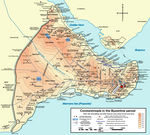Basketmakers' Kiosk
FatihHouses completed in 1592Music venues in IstanbulRedevelopment projects in IstanbulRestaurants in Istanbul ... and 1 more
Topkapı Palace

The Basketmakers' Kiosk (Turkish: Sepetçiler Köşkü), also known as Sepetçiler Palace (Sepetçiler Kasrı), named after the Sepetçi Roma (basketmakers), is a former Ottoman pleasure palace located on the southern shore of Golden Horn's mouth at Sarayburnu in the neighborhood of Sirkeci in Istanbul, Turkey.
Excerpt from the Wikipedia article Basketmakers' Kiosk (License: CC BY-SA 3.0, Authors, Images).Basketmakers' Kiosk
Kennedy Avenue, Istanbul
Geographical coordinates (GPS) Address External links Nearby Places Show on map
Geographical coordinates (GPS)
| Latitude | Longitude |
|---|---|
| N 41.016388888889 ° | E 28.981111111111 ° |
Address
Sepetçiler Kasrı
Kennedy Avenue
34110 Istanbul
Türkiye
Open on Google Maps









